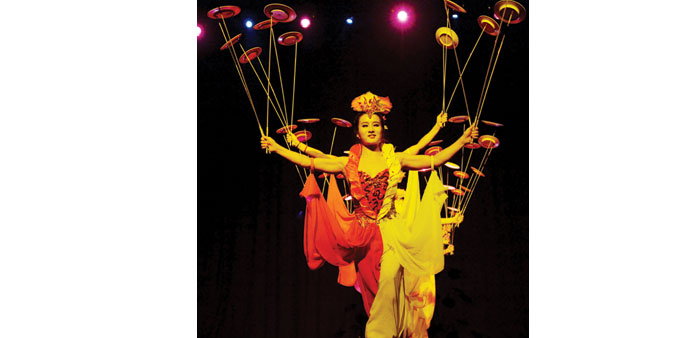By Umer Nangiana
They came and they mesmerised. The audience seemed to hold its breath from the moment Chinese acrobats entered the stage at Katara drama theatre right till the time they left after two hours.
They displayed what are nearly impossible-to-achieve contortions. Ever imagined a human body reverse-diving through multiple rings and a jelly fish balancing dozens of candles on all its tentacles, keeping them straight up in every single moment?
Yes, they made this possible and more — the first time in Doha — before a multi-cultural setting.
The show-stealer however, was the plate-spinning act performed by young female acrobats of Hunan Acrobatics Troupe from China. These acrobats from the Hunan province of China are globally recognised masters at this act having won multiple international prizes. The acrobats made every act look simple, smooth and breathtakingly, entertaining.
So how do these human robots achieve the thrilling perfection? The leader of the troupe Wu Youyun told Community there was no secret but hard work and practice.
“It takes an acrobat 10 years of training in order to perform for one minute on the stage,” said Youyun. The Hunan province is known for acrobatics which is a centuries old tradition. The acrobatic talent has to be spotted in a child at a very early age. Some acrobats start training as early as from the age of two.
It takes them years to achieve perfection and control over their body movements which need to be patterned in a flow that looks pleasing to every eye. Youyun said all 23 performers in acrobatics groups have been busy rehearsing for the show for days before they landed in Doha.
Since their arrival, they have been practicing and they slept very little just to give the audience a wonderful performance, said the group’s leader. “All of them were enthusiastic to show what they can do,” said Youyun.
The breathtaking choreography at Katara proved all that Youyun claimed. All the years of hard work was evident in the poetry in motion.
The spinning-plates act was the first to hit the floor.
The spectators that included a good number of locals, diplomats from different embassies accompanied by their families besides the members of Chinese community thoroughly enjoyed the act, forcing many to stand up in ovation.
Backstage, the acrobats told Community they were enjoying the show as much as the audience was jubilant watching them going up in the air.
Wang Caihong, the 20-year-old female performer who demonstrated her skills at the act of balancing candles, said she enjoyed flying through the air ring the most.
“There have been some accidents and I got hurt sometimes but just thinking about the smiles and the appreciation from the audience I get makes it worth the risk,” said the young acrobat.
Her male colleague, 28-year-old Li Choug, said he simply loved to see so many in audience applauding his performance. For him, his first ever performance was the most memorable experience.
Since an early age, anyone aspiring to become an acrobat is judged for talent and recruited in the training school. The leader of the troupe said the group has a special training school where they choose kids who are physically fit for the training.
Acrobatics is indeed a unique art. It requires hard training. Youyun told Community that a trainee in the school has to work the whole day long. The tasks include tough fitness training and acrobatics exercise besides courses on Chinese culture.
“They have to spend a lot of their time at learning Chinese culture since they are young in the acrobatic group,” said the head of the famous troupe.
In terms of food, he said, all except those who have to perform body bending movements, eat like other people. Those learning bending movements however, have to take care of their diet.
Youyun said street performances in different Chinese provinces were another great source of finding talent for acrobatics. For instance, one of the ethnic groups holds a traditional festival in which people have to climb ladders in the dark of night.
The master acrobats from the school keep an eye on such events to spot talent for acrobatics, the group leader added.
Generally, an acrobat retires at the age of 30 but it depends on the body strength and agility. Even after retirement, the acrobat remains closely attached to the game.
Since the Chinese government attaches great importance to players in acrobatics, most of them go on to work in cultural departments after retirement. Others continue to be trainers and captains of different groups of acrobatics.
Acrobats from a group, which is more than half a century old, from Hunan province has so far performed in over 50 countries and won prizes and awards. Youyun said the group of 23 acrobats that performed at Katara included mostly young performers who have showed their prowess in four or five countries. The youngest among was a 15-year-old female.
All performers loved Doha very much and they would love to come back again to repeat the performances, the troupe’s leader said.
Gao Youzhen, Chinese Ambassador to Qatar, and Katara’s top functionaries, said the acrobatics show and the other Chinese festivities received a huge response from the people of Doha. They said more of them would keep coming to Katara.
“We could see that all the seats in theatre were taken. All the leaders in the hall said it was unprecedented for any show here so it shows that Qatari people loved these performances,” said Ambassador Youzhen.
He thanked Dr Khalid Ibrahim al-Sulaiti, Katara’s general manager; and Darwish Ahmed al-Shebani, Director of cultural affairs and director of marketing and international affairs, for their efforts in making the show a huge success.
The Chinese ambassador said it was the first time that China had come together with Katara in organising such a cultural festival. The purpose was to enhance friendship between China and Qatar besides carrying forward Chinese culture and civilisation.
“We want to promote the bilateral relationship through our co-operation on the cultural front,” Youzhen added.
The Chinese ambassador thanked Darwish Ahmed
al -Shebani, who went to China, saw all these performances and decided to bring them to Doha.
The ambassador wished to see more of Chinese art and performances brought to Qatar in future.
Darwish Ahmed al-Shebani said the show would continue to be a success and that initiatives are afoot to earmark a China-Qatar Culture Year in the future.
About the Chinese festival, he said, it was generally for the Chinese community in Qatar, however the reaction here was amazing. “Although the language barrier is there but they have managed to break it and break it with a soft cultural touch at Katara,” said Ahmed.
He said the Chinese ministry of culture had put in a tremendous effort, putting in place a wide range of activities during his 12-day visit to China.



